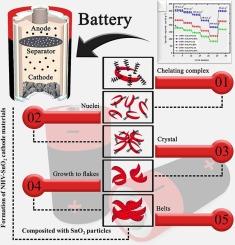调谐纳米氧化锡对钒酸铵纳米带阵列锂离子电池正极高存储可逆容量保持的建筑协同反应性
IF 4.6
3区 材料科学
Q2 MATERIALS SCIENCE, MULTIDISCIPLINARY
引用次数: 0
摘要
提高钒基材料的环境循环稳定性对于下一代高性能锂离子电池电极的发展至关重要。尽管通过调节用于快速储存 Li+ 的廊道空间来扩展这些寄主层状纳米体系结构说明了其有效的电化学活性,但所报道的钒基阴极在循环稳定性方面的结构完整性却极具挑战性。本研究通过基于声化学-煅烧-水热处理的三步法合成了一系列由不同含量的 SnO2(x:5.0、15.0 和 30.0 wt%)组成的 NH4V4O10-SnO2 (NHV-SnO2)纳米复合材料,并将其用作锂离子电池阴极的先进能量材料。人们首次将了解二氧化锰负载对基于 NHV 的电极的电化学反应的影响视为一种有效的工程策略,以优化结构调制和电池寿命,同时避免明显的容量衰减。值得注意的是,以最佳比例结合 NHV 和 SnO2 不仅能提高比表面积,还能扩大锂离子插层/萃取的体积变化缓冲。通过这种设计,含有 15.0 wt% SnO2 的组装电池在 50 次循环中的稳定容量分别为 301.77 mAh g-1(30 mA g-1)和 232.05 mAh g-1(240 mA g-1),容量保持率分别高达 97.94 % 和 97.03 %。值得注意的是,这里描述的结果为设计更好的基于复合材料的储能设备阴极材料提供了重要指导。本文章由计算机程序翻译,如有差异,请以英文原文为准。

Tuning architectural synergy reactivity of nano-tin oxide on high storage reversible capacity retention of ammonium vanadate nanobelt array cathode for lithium-ion battery
Enabling ambient cycling stability of vanadium-based materials is of fundamental importance in the advancement of next generation electrodes for high-performance lithium-ion batteries. Although, extending these host layered nano-architectures illustrate the effective electrochemical activity by regulating the gallery space for fast Li+ storage, the reported structural integrity in terms of the cycling stability for vanadium-based cathodes is highly challenging. In present study, a series of NH4V4O10-SnO2 (NHV-SnO2) nanocomposite consisting of diverse contents of SnO2 (x: 5.0, 15.0 and 30.0 wt%) were synthesized through a three-step program based on sonochemical-calcination-hydrothermal treatment and employed as an advanced energetic material for lithium-ion battery cathodes. For the first time, understanding the impact of SnO2 loading on electrochemical reactions of NHV-based electrodes was regarded as an effective engineering strategy to optimize structural modulation and cell lifetime without distinct capacity fading. Notably, combination of NHV and SnO2 in optimum proportions not only enhances the specific surface area, but also expand buffer the volume change for lithium-ion intercalation/extraction. By this design, the assembled battery containing 15.0 wt% SnO2 illustrated stable capacities of 301.77 mAh g−1 (30 mA g−1) and 232.05 mAh g−1 (240 mA g−1) with capacity retention values as high as 97.94 % and 97.03 % for 50 cycles, respectively. Of note, the results described here could show a vital guidance toward designing better composite-based cathode material for energy storage devices.
求助全文
通过发布文献求助,成功后即可免费获取论文全文。
去求助
来源期刊

Materials Science and Engineering: B
工程技术-材料科学:综合
CiteScore
5.60
自引率
2.80%
发文量
481
审稿时长
3.5 months
期刊介绍:
The journal provides an international medium for the publication of theoretical and experimental studies and reviews related to the electronic, electrochemical, ionic, magnetic, optical, and biosensing properties of solid state materials in bulk, thin film and particulate forms. Papers dealing with synthesis, processing, characterization, structure, physical properties and computational aspects of nano-crystalline, crystalline, amorphous and glassy forms of ceramics, semiconductors, layered insertion compounds, low-dimensional compounds and systems, fast-ion conductors, polymers and dielectrics are viewed as suitable for publication. Articles focused on nano-structured aspects of these advanced solid-state materials will also be considered suitable.
 求助内容:
求助内容: 应助结果提醒方式:
应助结果提醒方式:


